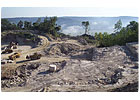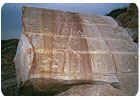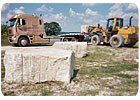
In 2006, after a five-year partnership with another stone company, William Scott Elliott split off to begin Capstone Rock Products LLC of Marietta, OH, an offshoot of his third-generation family-owned-and-operated industrial manufacturing business. He continued leasing and developing the aged New Castle Quarry because of its unique sandstone.
The Elliot family has worked with sandstone and limestone since the 1950s in its Ohio River based manufacturing and river frontage land and building restoration. From their quarry, they now produce what the company refers to as “Scot-Stone.” The material has been referred to as Briar Hill sandstone, but to separate its product from a similar product trademarked in 1917 by the Briar Hill Stone Co., the name Scot was designated for the material. “It is appropriate being that the owner’s middle name is Scott and because his entire family descends from Scotland,” explained David Paige, the company’s Marketing and Product Manager.
The company’s production comprises 75% sandstone for building fascia and ornamental carvings, and 25% in different sizes of by-products of the quarried material, typically used for landscape boulders, retaining walls and waterfall features. “Many landscapers love this sandstone because of the unique color of the material with its golden graining,” said Paige. “The sandstone sits geologically in Ohio’s Massillon geological ridge, which ranges from the south of Cleveland down into the center of Ohio.”

Quarrying process
Although Capstone Rock Products LLC is currently relying on precision blasting to extract stone from the quarry, it is in the process of examining hydrocutting methods, according to Paige. “We are used to blasting with low grain and precision cutting, but with hydrocutting, you can cut a 20,000-pound cube out with water, and you get a better end product,” he said, adding that with precision blasting, you only get a rough cut of the outside of the stone, rather than a crisp clean cube you obtain from hydrocutting. “With our current method, we don’t always know exact interior color until we start cutting into the stone.”“Beautiful color variation is our strength, but can present unique problems in identifying and segregating specific job requirements, thus we are constantly experimenting with newer methods of extracting the stone,” he continued. “Hydrocutting should present us with less waste and [resulting stone pieces that are] easier to surface identify what is inside. Of course, as in any method, cost of extraction will be a big factor, and thereby we will most likely continue blending several methods, both old and new, with subcontracted experts, to continue producing world-class stone.”
Currently, after blasting is completed, 15,000 to 20,000-pound cubes of sandstone are pulled from quarry step-shelves using 980 Caterpillar front-end loaders. “We take the front-end bucket off of the loader and put large forks on it, and use the machine as a giant forklift,” Paige explained. “We use a low grain detonating cord - 50-grain - for blasting. The cords are placed every 6 inches in drill holes, which gives a nice clean precision cut separating blocks from the shelf face by about an inch, then we pull them out with the forklift.”
The company also utilizes a standard precision drill for hole drilling. Dunnville Cutstone Co. of Menomonie, WI, handles all of Capstone’s precision drilling using low-grain detonation cord with B-Gel compound as its stemming, which has proven to be the lowest cost and highest yielding method, according to Dunnville. “They are very good at what they do,” said Paige, who added that prior to enlisting Dunnville, Capstone was finding too much damage in the stone.

Current production
Although the quarry sits on 148 acres of land, Capstone is only currently extracting stone from 4 acres. “Eventually, we will probably work other areas, but for now we have excellent stone in these 4 acres where stone has been pulled out for almost 200 years now,” said Paige.Capstone sells its products to distributors and through large stonecutters to major jobs, like an ongoing project at Yale University, for which the company is currently producing material. Currently, the company sells direct to large jobs and through distributors, and does not have an actual retail outlet, but plans to establish one in the future. “For now, we quarry it, cut it and truck it,” said Paige.
“For most jobs, architects send out an engineer, and I take them out walking the quarry shelves matching desired color requirements. Depending upon the job, we work different parts of the quarry,” he explained.
Capstone is currently in the process of producing 20,000-pound cubes of golden sandstone for Yale University’s “Cross Campus Library.” “Quarra Stone of Madison, WI, refined the stone from our large cubes into the finished product that the architect was looking for,” explained Paige. “They have many years of precision work for major universities, on prestigious buildings whose architectural teams desire to leave a legacy in stone, not imitation products. Their carving and cutting keeps the Old World arts alive.
“We work in conjunction with some of the country’s best, most experienced stonecutters, like Del Hammond of Flat Rock, OH, the 70-year-old pro who has been cutting jobs for countless grand public buildings and colleges since the age of 16,” he continued.
Paige has recently developed a new product for the company in response to a request for a specific look. “I have just developed a product in which I use darker browns mixed with gold and buff, and even rose, split-faced to obtain what I like to call a Victorian or Old World look,” said Paige. “There was a great demand with local landscape designers who were looking for this type of stand-alone cut wall that they can build for backyards.
“As a relatively small firm in the world of stone, competing with the multinational-owned mega quarry systems, we feel our niche is in the small hands-on quality jobs, in which we can still retool, change course and troubleshoot the individual needs of the client,” Paige explained. “We enjoy providing a homebuilder’s new fireplace mantle, hearth and shower capstone cut from the very same batch of quarried blocks as our Yale job. That gives the client a thrill to be part of something prestigious.”


